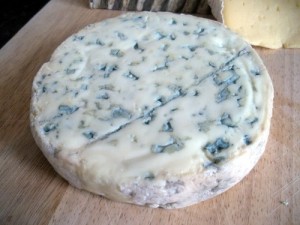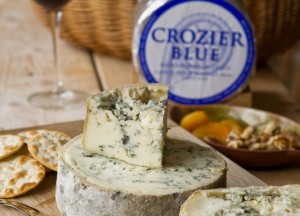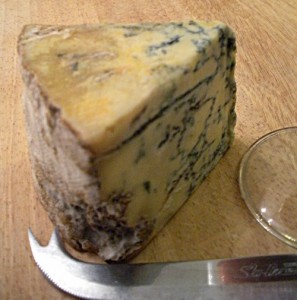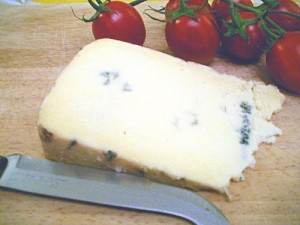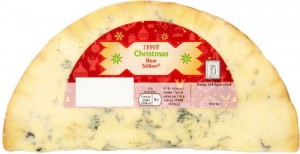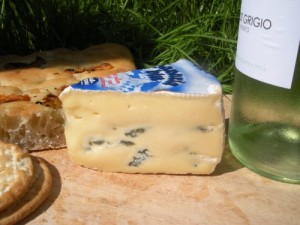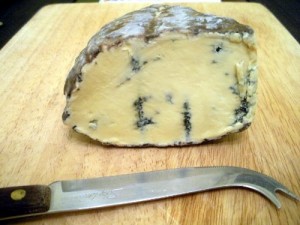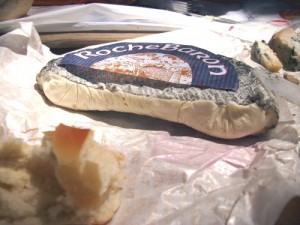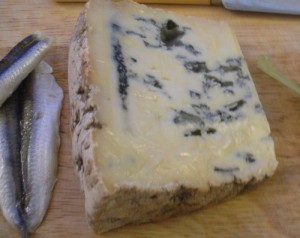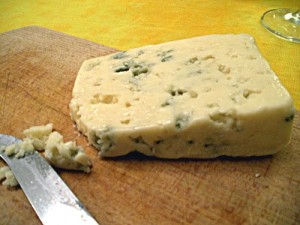Archive for the ‘Blue’ Category
Fourme d’Ambert
January 29th, 2017 Posted 6:48 pm
Fourme d’Ambert is one of the oldest known cheeses, dating back to the Roman occupation of France, around 2,000 years ago. The recipe, that is, not the actual cheese which is normally only aged for a month or two.
Traditionally made in a cylindrical “fourme” (French Auvergnat dialect for mould) about 5½” (13cm) diameter and 7½” (19cm) tall, the wheel is unusually tall for its diameter. Usually, it is sold in slices across the wheel rather than wedges.
Soft and yielding, almost spreadable, dusted in a white/grey mould. The pate is off white to dark cream (depending upon age) and flecked with greenish blue. It’s a delightfully appealing cheese from the offset.
The smell is slight, almost non-existent. The texture is deliciously smooth and creamy, yielding pleasantly in the mouth. The flavour likewise is smooth and creamy, delicate with hints of blue. It could be described as similar to a very mellow Roquefort, not so sharp and a lot less salty.
It is a generally pleasant cheese, inoffensive and well behaved. A perfect blue addition to the cheeseboard when you might not want to overwhelm your guests.
Easily available from many supermarkets.
Reviewed by Nick & Olympia, 2011.




 (4/5)
(4/5)
Posted in 4 Stars - Very Good, Blue, Cow's milk, French, Semi-soft
Crozier Blue
December 14th, 2014 Posted 7:41 pm
| With a name like Crozier, you might expect this cheese to be French, but it is in fact, Irish. A crozier is a shepherd’s crook (Which is actually taken from the French word croisier, meaning cross bearer. A crosier, or crozier, is the staff with a cross or crook, that signifies an abbot or bishop. But, enough of that, this is a cheese blog, not an etymology class.)
Crozier is made by Cashel Farmhouse Cheesemakers and the name was chosen because the Rock of Cashel is where St. Patrick’s crozier is set in a statue… and this is a sheep’s milk cheese (you see what they did there? It has a thin grey, sticky rind and a sweaty, cream coloured pate with blue / grey veining. The smell is somewhat reminiscent of a schoolboy’s dirty kit bag. Sweaty, but lacking the pungency of masculine pheromones. However, don’t let this put you off. The texture is strangely grainy, like semolina pudding. The flavour salty and sharp with quite a bite and a subtle sweetness that creeps in. Usually blue cheeses are best when taken with sweeter wines, but this combination produces a peculiar metallic aftertaste. Maybe it’s the sweetness of the cheese, but a drier wine is much better. Having said all this, Crozier is a good cheese. It’s strange quirks make it an interesting addition to the cheeseboard. |
Produced by Cashel Farmhouse Cheesemakers.
Purchased from La Cave a Fromage, Brighton.
Reviewed by Nick & Olympia, 2014.




 (3/5)
(3/5)
Additional
A couple of weeks after purchase, it improved considerably. The texture became smoother and creamier and the flavour, much more mellow and satisfying. As a result, we had to re-evaluate our rating.




 (4/5)
(4/5)
Posted in 4 Stars - Very Good, Blue, Hard, Irish, Sheep's milk
Wensleydale Blue
October 5th, 2014 Posted 6:25 pm
Most people will be familiar with Wensleydale. Very white, sharp, crumbly and often found in supermarkets, flavoured with cranberries or apricot. Few will know about the blue variety, fewer still will know that Wensleydale was once always blue.
In the 14th century when Cistercian monks settled in Wensleydale, Yorkshire, they started making cheese (as monks tend to do). Having come from the Roquefort region of France, the recipe they brought was for blue cheese. Somewhere in its history, it became the white cheese we are now familiar with. The blue version is now rare.
The rind is dark and gnarled, dusted in fluffy moulds. The pate is a pale yellow with dark blue veining.
Though the smell is not strong, it is somewhat reminiscent of old socks with a hint of blue.
It is quite crumbly, though not as much as its cousin, the texture is creamy and smooth. Though it may look fearsome, it has a very pleasant mild, blue flavour, with none of the expected Wensleydale acidity and a mellow lingering aftertaste. A bit Stilton like, but not as strong.
It looks a bit uncouth, but is actually very civilised.
Produced by the Wensleydale Creamery.
Reviewed by Nick & Olympia, 2012.




 (3.5/5)
(3.5/5)
Posted in 3 Stars - Good, Blue, Cow's milk, English, Hard
Brighton Blue
May 11th, 2014 Posted 7:58 pm
Since we are located very near to Brighton, we couldn’t justifiably not review this… although it’s not actually made in or around Brighton, but instead, some twenty miles away, in Horsted Keynes. I guess, this is because no one knows where Horsted Keynes is, but everyone knows Brighton. No? – Well, walk directly south from London until your feet get wet ![]()
The rind is sticky, a shade or two darker than it’s ivory pate and flecked with white and green/blue moulds. The pate itself is quite sparsely veined with starkly contrasted grey/green/blue moulds.
The smell is a delicate combination of sweet milkiness and mould. The texture is crumbly, but with a smooth sticky butteriness.
Mildly blue, slightly acidic with a fresh sharpness a bit like a mild Caerphilly, leaving you with a salty aftertaste.
It’s pleasant and inoffensive, with enough bite to make it mildly interesting.
Produced by High Weald Dairy.
Purchased from Cheese Please, Lewes.
Reviewed by Nick & Olympia, 2013.




 (2.5/5)
(2.5/5)
Posted in 2 Stars - OK, Blue, Cow's milk, English, Hard
Stilton
December 22nd, 2013 Posted 7:37 pm
With Christmas just around the corner, Stilton becomes an obvious choice for a post. In the weeks leading up to Christmas, many supermarkets are offering huge slabs of this famous festive favourite for very little money… but are they any good?
For reasons unknown, Stilton seems to have become associated with Christmas eating. Like dates, walnuts and Brussels sprouts, although available throughout the year, many people will only buy them over the Yuletide period. Is it because these things are considered so horrid that they can only be consumed once a year, under heavy intoxication?
In the past, I remember supermarket Stilton as this harsh, acidic, very strong wedge shaped lump that would attempt strip the lining of your mouth as you ate it. Indeed, I’m sure there are still shops that sell such gastric monstrosities together with spam and tinned boiled potatoes.
However, things have changed, and for the better. Whether the manufacturers or supermarkets have learned that this strategy does little for repeat sales and reputation, I don’t know, but the cheese has improved immensely and this can only be a good thing ![]()
It’s good, really very good, like Stilton should be. Strong in flavour, but not in attitude. Smooth and creamy both in texture and taste, with a robust, but not overpowering blueness. Just scrummy and for £4 for 550g (Tesco price), you can’t really go wrong.
Purchased from Tesco.
Reviewed by Nick & Olympia 2013.




 (4/5)
(4/5)
Posted in 4 Stars - Very Good, Blue, Cow's milk, English, Hard
Bavaria Blu
December 8th, 2013 Posted 8:47 pm
Sometimes sold under the name of Cambazola or Blue Brie, this pleasant little cheese that is easily available in many supermarkets. Though the alternative names suggest it could be Italian or French, it is actually German.
It is, by all accounts a blue Brie, using the same recipe as ordinary Brie. However, introducing the blue moulds is somewhat unconventional. Normally, the mould culture is added to the milk. During maturation, and starved of oxygen, it lies dormant until stainless steel wires are used to puncture the rind. With Bavaria Blu, the mould culture is introduced during maturation by injecting it directly into the cheese. This causes the blue moulds to be localised into little pockets rather than veins that pervade the paste.
Coated with a soft, dusty, edible, white rind. It has a cream to white paste, mottled with blue splodges, making it a quite attractive looking cheese.
Like a Brie, it has little or no smell, but unlike Brie it doesn’t produce a smell of ammonia when it gets really ripe.
It has a soft creamy texture, interspersed with the slightly harder patches of blue. A soft, delicate Brie like flavour with a gently blueness. As blue cheeses go, it is very inoffensive. A blue cheese for people that don’t like blue cheese.
Purchased from most leading supermarkets.
Produced by various manufacturers including: Cambazola, Bergader & Edelweiß
Reviewed by Nick & Olympia 2012




 (3/5)
(3/5)
Posted in 3 Stars - Good, Blue, Cow's milk, German, Semi-soft
Barkham Blue
October 27th, 2013 Posted 7:03 pm
This appealing soap-bar shaped cheese is made with Jersey cow’s milk, giving it a golden yellow colour and creamy texture.
Covered in a thin, sticky dark brown mouldery skin, it smells like damp stone. The skin is a little odd because it can almost be peeled off.
The pate is a creamy, golden yellow colour with dark contrasting bottle green veining. The texture, like brandy butter, soft and buttery, yet it breaks and crumbles under pressure.
It melts in the mouth with a sharp, blue flavour. It’s strong, but not aggressive, with a metallic “twang” and a slight fruitiness.
Note. As it ages, these interesting qualities fade and it can become unexciting.
Produced by: Two Hoots Cheese
Purchased from: Cheese Please, Lewes.
Reviewed by: Nick & Olympia 2012 & 2013




 (3.5/5)
(3.5/5)
Posted in 3 Stars - Good, Blue, Cow's milk, English, Hard
Rochebaron
September 1st, 2013 Posted 5:46 pm
We found this delightful blue cheese on a recent trip around France. We bought another one to bring home with us, but somehow it didn’t seem quite as good. Maybe, it was the fact that the one pictured, had been sitting in a warm car for a few days. Or perhaps it was a psychological effect of tasting better when you’re on holiday, picnicking under the trees.
A greenish grey ash rind about 6″ (15cm) diameter and 1″ (2.5cm) thick. Persillée (parsley), the French call this style of blue. Creamy white interior with flecks of green. Though the rind looks a little leathery, it is actually soft and pretty tasteless.
It has a lovely texture with a very mild, delicate flavour and doesn’t taste blue at all. Not exciting, but very pleasant.
Purchased from Carrefour, Dunkerque.
Reviewed by Nick & Olympia 2013.




 (3.5/5)
(3.5/5)
persillée
Posted in 3 Stars - Good, Blue, Cow's milk, French, Soft
Binham Blue
August 4th, 2013 Posted 4:20 pm
Soft creamy yellow with starkly contrasting deep green/blue veins, a gnarled rind dusted in white moulds. This looks just like a blue cheese ought to.
The paste is soft and yields under pressure, but not quite enough to spread.
It has a very mild creamy taste, with bitter overtones, but not in the least bit sharp, like so many other blue cheeses. Other than that, there is little to say. It’s OK… a blue cheese for people that don’t like blue cheese.
It looks fantastic, and creates an anticipatory expectation that, sadly, fails to be met.
Purchased from Larners, Holt.
Reviewed by Nick & Olympia 2012




 (2/5)
(2/5)
Posted in 2 Stars - OK, Blue, Cow's milk, English, Semi-soft
Beenleigh Blue
July 14th, 2013 Posted 6:26 pm
Wet and lumpy with randomly shaped holes and delicate blue veining, this cheese looks a bit like a yellowish Roquefort, but that’s where the similarity ends.
It has a pleasing, soft and crumbly texture. On first tasting, it is intensely blue, a bit like a Danish blue. From this, you imagine that what will follow will be sharp and acidic. You prepare yourself for the for the bite… but it never materialises.
What actually happens is rather weird and somewhat hard to describe. There’s a strange acetone like, alcoholic hit. Like someone’s hidden a sliver of pear drop in it, or opened a bottle of nail polish. This quickly disappears and leaves you with a very distinct walnut and burnt toffee like aftertaste. It almost doesn’t taste like cheese at all. Most unexpected, but thoroughly enjoyable.
Fantastic, because it is so unusual!
Purchased from Cheese Please, Lewes.
Reviewed by Nick & Olympia.




 (4/5)
(4/5)
Posted in 4 Stars - Very Good, Blue, English, Hard, Sheep's milk

